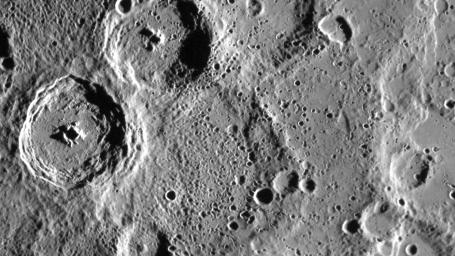
|
A New View of Spitteler and Holberg
- Click the image above for a larger view
- Full-Res JPEG (1920 x 1080) (339.3 kB)
- Full-Res TIFF (1920 x 1080) (2.1 MB)
Caption:
This image is a mosaic of multiple images. North is toward the upper right corner. The crater on the left of the image is Spitteler, while the neighboring crater to the right extending out the top of the image is Holberg. Both craters were viewed by Mariner 10, but MESSENGER's polar orbit offers a new view of these craters and the surrounding terrain.
Date acquired:
March 30, 2011
Instrument:
Narrow Angle Camera (NAC) of the Mercury Dual Imaging System (MDIS)
Center Latitude:
-67.2°
Center Longitude:
305.9° E
Resolution:
150 meters/pixel
Scale:
Spitteler has a diameter of 67 kilometers (42 miles)
Background Info:
On March 17, 2011 (March 18, 2011, UTC), MESSENGER became the first spacecraft ever to orbit the planet Mercury . The mission is currently in its commissioning phase, during which spacecraft and instrument performance are verified through a series of specially designed checkout activities. In the course of the one-year primary mission, the spacecraft's seven scientific instruments and radio science investigation will unravel the history and evolution of the Solar System's innermost planet. Visit the Why Mercury? section of this website to learn more about the science questions that the MESSENGER mission has set out to answer.
These images are from MESSENGER, a NASA Discovery mission to conduct the first orbital study of the innermost planet, Mercury. For information regarding the use of images, see the MESSENGER image use policy .
Cataloging Keywords:
| Name | Value | Additional Values |
|---|---|---|
| Target | Mercury | |
| System | ||
| Target Type | Planet | |
| Mission | MESSENGER | Mariner |
| Instrument Host | MESSENGER | Mariner 10 |
| Host Type | Orbiter | Flyby Spacecraft |
| Instrument | Mercury Dual Imaging System (MDIS) | |
| Detector | Narrow Angle Camera (NAC) | |
| Extra Keywords | Crater, Grayscale, Radio | |
| Acquisition Date | ||
| Release Date | 2011-04-24 | |
| Date in Caption | 2011-03-30 | |
| Image Credit | NASA/Johns Hopkins University Applied Physics Laboratory/Carnegie Institution of Washington | |
| Source | photojournal.jpl.nasa.gov/catalog/PIA14206 | |
| Identifier | PIA14206 | |
